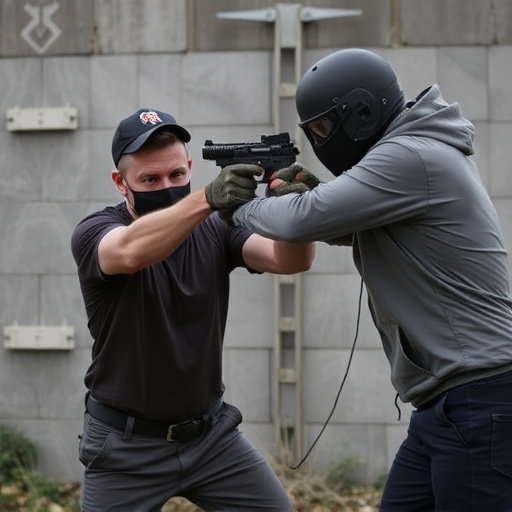Stun Gun Regulations & Monthly Maintenance Tips for Optimal Safety
Understanding concealed carry laws is crucial before considering a stun gun, as regulations vary wid…….
Understanding concealed carry laws is crucial before considering a stun gun, as regulations vary widely by state and region, impacting who can own them, where, and under what circumstances. These laws involve background checks, training requirements, and permit renewals. Staying informed about local guidelines, including monthly maintenance tips like battery checks and inspections, ensures reliable device functionality and legal compliance. Regular training on device operation, safety practices, and understanding legal implications is vital for responsible stun gun ownership. Adhering to these measures promotes safety, effective self-defense, and avoids legal issues.
“Uncover the regulations surrounding concealed carry stun guns with our exhaustive guide. From understanding complex laws to navigating regional restrictions, this article provides a comprehensive overview. Learn about crucial factors like stun gun maintenance, ensuring optimal performance through essential monthly checks.
Explore safety precautions, training requirements, and legal considerations for obtaining permits. Discover what you need to know before carrying a stun gun legally. Find expert tips on stun gun monthly maintenance tips for peace of mind.”
- Understanding Concealed Carry Laws: A Comprehensive Overview
- Stun Gun Regulations Across Different Regions
- Monthly Maintenance Checklist for Optimal Performance
- Safety Precautions and Training Requirements
- Legal Considerations and Permits: What You Need to Know
Understanding Concealed Carry Laws: A Comprehensive Overview

Understanding concealed carry laws is essential for any individual considering the acquisition and usage of a stun gun. Each state has its own set of regulations dictating who can carry a stun gun, where, and under what circumstances. These laws often require thorough background checks, specific training, and even periodic renewals or updates to permits. It’s crucial to stay informed about local and state guidelines, especially when it comes to stun gun monthly maintenance tips. Regular upkeep ensures the device remains reliable and functional, adhering to legal requirements for its use.
Knowing these regulations beforehand can help avoid legal repercussions and ensure a secure environment for carrying a stun gun. Many states differentiate between resident and non-resident permits, with varying application processes and restrictions. Additionally, certain locations may have ‘no-go’ zones where stun guns are prohibited, even with valid permits. Staying within the confines of these laws not only keeps you safe but also empowers you to protect yourself effectively while adhering to legal boundaries.
Stun Gun Regulations Across Different Regions

Stun gun regulations vary greatly across different regions, making it crucial for individuals to understand the local laws before considering concealed carry. In some areas, stun guns are treated similarly to firearms, requiring permits, registration, and adherence to strict safety guidelines. These regions often mandate regular stun gun monthly maintenance tips, such as checking battery life, ensuring proper functionality, and storing the device securely.
In contrast, other jurisdictions have more lenient rules, allowing open or concealed carry with minimal restrictions. However, even in these areas, there may be specific requirements for stun gun size, power output, and trigger mechanisms. It’s essential to stay informed about local regulations and follow best practices for stun gun maintenance to ensure safety and comply with the law, including regular inspections and proper storage.
Monthly Maintenance Checklist for Optimal Performance

Regularly maintaining your stun gun is crucial for ensuring its optimal performance and reliability when you need it most. Here’s a simple monthly maintenance checklist to keep your stun gun in top shape: start by thoroughly cleaning the device with a soft, dry cloth, removing any visible debris or fingerprints from the surface. Then, use an ISO-certified cleaner specifically designed for stun guns to wipe down all metal surfaces, including the trigger mechanism and contacts. After cleaning, apply a thin layer of lubricating oil to moving parts like the trigger and slide to prevent corrosion and ensure smooth operation.
Don’t forget to check the battery level each month. Stun guns rely on reliable batteries for their functionality, so it’s essential to replace them as soon as they show signs of wear or loss of charge capacity. Additionally, inspect the stun gun for any signs of physical damage, such as cracks in the housing or damaged contacts. If you notice any issues, address them promptly by seeking professional repair or replacement parts to maintain the device’s safety and efficiency.
Safety Precautions and Training Requirements

When considering concealed carry, especially with a stun gun, it’s paramount to prioritize safety. Regular training is essential to ensure users understand the device’s functionality, operation, and safe handling practices. This includes learning about de-activation procedures, proper storage, and monthly maintenance tips like battery checks and overall device inspection. Such precautions are critical in mitigating accidental discharges and ensuring the stun gun remains reliable when needed most.
Training should also cover situational awareness, self-defense strategies, and legal implications of using a stun gun. Understanding local regulations regarding concealed carry permits and stun gun ownership is vital to avoid legal complications. Regular refreshers and advanced training can help maintain proficiency, ensuring individuals are prepared to use their stun guns effectively while adhering to safety standards.
Legal Considerations and Permits: What You Need to Know

When considering concealed carry, especially with a stun gun, understanding legal considerations and permit requirements is paramount. Each jurisdiction has its own set of rules regarding who can possess and carry stun guns, as well as where and how they can be used. It’s crucial to research and comply with local, state, and federal laws. Permits for stun gun carry may require background checks, training certifications, and even specific reasons for possession, such as personal protection or employment-related needs. Staying informed about these legal aspects ensures you’re not only compliant but also prepared for responsible stun gun ownership and monthly maintenance to keep it in optimal condition.
Regular stun gun monthly maintenance tips include keeping the device clean, ensuring proper charging, and inspecting for any signs of damage or wear. Following manufacturer guidelines is essential for maintaining functionality and reliability. Remember, a stun gun is not just a tool but a serious responsibility, and adhering to legal requirements and proper care practices demonstrates your commitment to safety and responsible ownership.
In conclusion, navigating concealed carry stun gun regulations involves understanding both local and regional laws, adhering to safety precautions, and ensuring proper training. Regular stun gun monthly maintenance tips are essential for optimal performance, safeguarding your investment, and maximizing its effectiveness when needed. Remember, legal considerations and permits vary widely, so always consult official sources before purchasing or carrying a stun gun.


